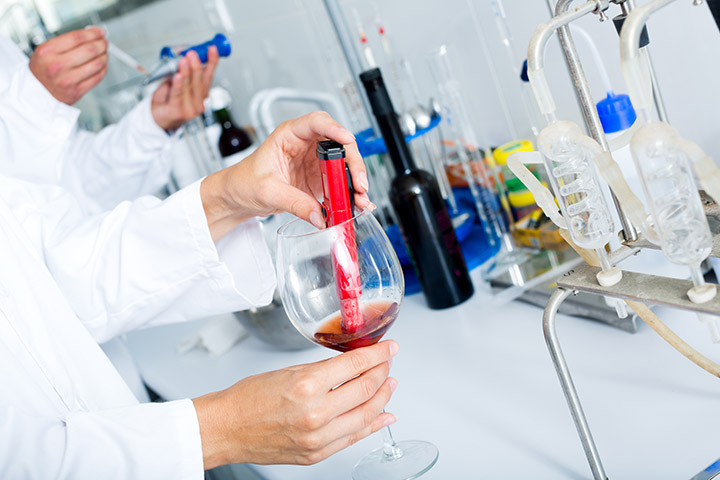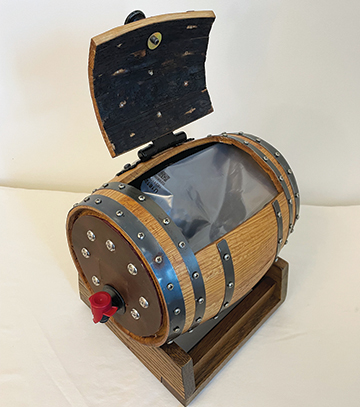Finding the Right Closure
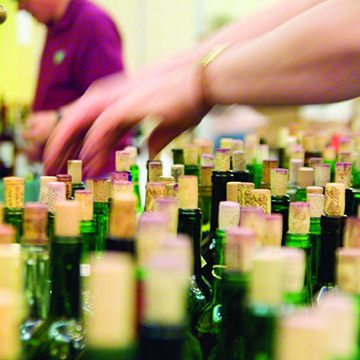
You have been diligent through every step of the process in making the best quality wine that is perfect for your palate. You have been a tireless caregiver, shepherding the growth and evolution of this living elixir for many months, even years, once you factor in bulk and possibly barrel aging, and it is finally time to bottle. You have properly cleaned and sanitized all the necessary bottles and bottling equipment and filled your bottles to a consistent and perfect level. You are now ready to insert/apply a closure into/onto the neck of the bottle. How important is that closure? Does it really matter what kind of closure you use? Might it have any impact on the wine that you worked so hard to create and are excited to share with your friends and family? I can personally answer that question based on my experience in one word — absolutely!
It is important to remember that wine is an ever-changing liquid. There are constant physical and chemical processes that continue over its lifetime. This includes its time in the bottle. Arguably, a wine’s time in the microenvironment of a 750 mL glass bottle can make all the difference of the final wine that actually is poured into a glass to either enjoy or find flaws in. It is either evolving, at its best, or degrading in the bottle. The time and way this happens is greatly influenced by the closure that is used to seal that bottle. Bear in mind that the environmental conditions where that bottle is stored (temperature, light, humidity, vibration, etc.) are also critical to this evolution, but in this discussion we will focus on the closure.
A Bit of History
Glass wine bottles, as we know them, became available in the 1600s with the invention of the coal furnace. It allowed for the blowing of thicker glass bottles that were difficult to break. Prior to this, dating back to the ancient Egyptians, Amphorae were used widely. Amphorae were typically ceramic earthen pots that came in many shapes and sizes with two handles and a slim neck that reduced the amount of wine exposed to oxygen. These were originally sealed with clay stoppers.
The Greeks and Romans switched over to cork stoppers as they found they worked best. Cork stoppers, made from the bark of Quercus suber cork oak trees native to southwest Europe and northwest Africa, have been around for a very long time. They were even used in ancient Egypt; being found in tombs dating back thousands of years. The ancient Greeks discovered that when cork was stripped from the trees a new sheath of better quality was quickly formed on the tree in the place of the old one.
Cork has been the gold standard for sealing wine bottles for a very long time. As cork is a natural product that is harvested, however, it is subject to environmental conditions that can lead to contaminants being housed in the cork. If not cleaned properly, a natural cork can cause wine spoilage.
One major player in this arena is 2,4,6 – trichloroanisole, or TCA, also referred to as cork taint. Minuscule amounts of TCA in a wine can spoil its aromas and flavors; exhibiting musty wet cardboard characteristics. A wine exhibiting this fault is said to be “corked.” The term corked came from the knowledge that this flaw most commonly comes from an infected cork closure. It should be noted that TCA can sometimes come from unsanitary practices in the winery as well.
Because of TCA and other contamination and spoilage issues, alternate forms of wine bottle closures have been developed. This evolution goes along with “super cleaning” processes and detection methods that have been instituted by some natural cork based manufacturers.
Closure Options
Modern day winemakers have many options to choose from when it comes to wine bottle closures. Let’s take a look at the pros and cons of what’s available to us home winemakers.
Natural Cork
Natural cork has the longest history of being utilized to close and seal wine bottles. Natural corks come from the process of single punching cork oak tree bark. As this is a completely natural product, no two corks are exactly the same. Corks from this process are visually inspected and are graded (on a 1–10 scale) based on the level of imperfections seen on the cork. A grade 1 cork would be visually perfect with no cracks and obvious porous spots found. These imperfections increase with higher populations of worms and fungi living in/on the tree. Most of the natural corks produced today come from Portugal. Other countries in the Mediterranean and southern Atlantic seaboard also provide cork (Spain, Italy, France, Morocco, Algeria, and Tunisia); primarily for wine bottle closures.
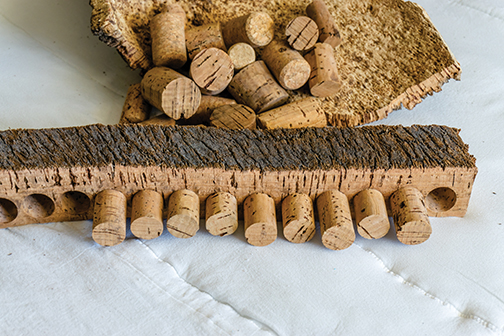
Grade 3 natural corks are most commonly used for wine bottle closures; providing a balance between cost and quality. Grade 1 and 2 natural corks have been historically reserved for much more expensive wines as these corks can be quite pricey in themselves. Even grade 1 and 2 corks can lead to corked wines. As these are completely natural products, it comes down to the level of cleaning and olfactory inspection that is utilized to minimize the level of spoilage and taint of wine through the use of natural corks. The level of TCA contamination that is reported and expected by the cork industry is between 1–2%. This doesn’t even touch on the issue of a phenomenon known as bottle variability. For me personally, this is a larger concern than even TCA spoilage. I’ll go into a bit more detail on this topic in the next section.
Agglomerated Corks
Agglomerated corks are made from the leftover cork bark that has been punched. It is ground up into small pieces that are then reformed into a cork shape and held together with a food-grade adhesive. These closures can vary dramatically by manufacturer. In fact, they can vary widely even by batch; particularly among the lower price point ones.
Early in my home winemaking hobby I often utilized these types of closures. They were readily available from my local winemaker supply shop and inexpensive. Well, you know the old adage “you get what you pay for?” This is where I learned the hard way about the issue of bottle variability. Let’s use a commercial case of wine as an example. You’ve just gone and done a wine tasting at a local boutique winery and settled on a wine that you absolutely love and end up bringing a case of it home. You get home and in your excitement about this treasure you uncovered you pull out a bottle and pop the cork. You pour a bit in a glass, put it to your nose and you get the dreaded musty wet basement smell. The bottle is corked! Oh well, it can happen right (1–2% as reported by the cork industry)? So you pop open another bottle. This one has no musty basement odor, thankfully, but the flavors and aromas are very muted; nothing like the wine you fell in love with at the tasting room. Frustrated, you open a third bottle and this one tastes completely different once again; even more acidic and on the verge of being spoiled. Another comes out and finally you are greeted by what you tasted in the tasting room. This is what is known as bottle variability. I had this happen to me with my own wines early in my hobby winemaking. This phenomenon can occur with natural cork-based closures due to their variability.
Micro-Agglomerated Corks
A more recent advance in the natural cork industry for wine bottle closures has been the advent of micro-agglomerated corks. These corks also utilize ground up pieces of the natural cork bark left over from the single punching process, however the pieces are ground much smaller than the regular agglomerated corks and sorted for uniformity in size. The cork is cleaned to remove all contaminants (which is easier to do with the smaller pieces) and then reformed and held together with an acid-tolerant food-grade adhesive, such as polyurethane. These closures can also be engineered and reformed with specific oxygen transfer rates (OTRs). The OTR of a closure is very important to know based on the style and type of wine you plan to store and/or age. A very low OTR would be desired for something like an ageable tannic red wine while a higher OTR may be more appropriate for an early drinking white or rosé. What is key in this and one of the biggest benefits of these closures is consistency. They are consistent in their makeup, based on what you chose for what you are after in the bottle aging of your wine. This consistency leads to the reduction, if not total mitigation, of bottle variability. I personally have used these types of closures with great success. Specifically, I have used DIAM closures. Good seals with no bottle variability.
Colmated Corks
Colmated corks are single punch natural corks that are far from flawless. Not of a high enough quality to pass as a natural cork, the imperfections in these corks are filled with cork dust and a food-grade adhesive. The process allows them to be a more smooth and consistent looking cork. They come at a lower cost than natural cork, with many of the same benefits and potential risks.
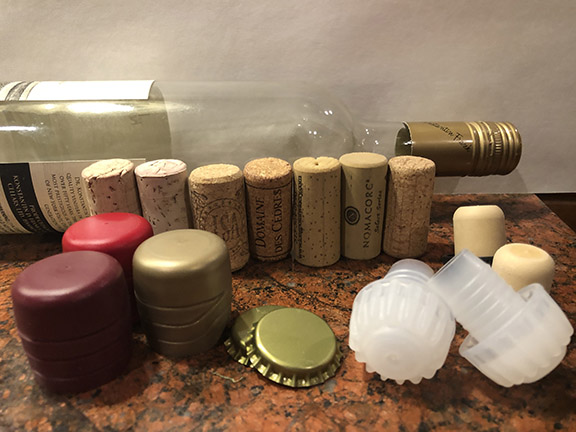
Synthetic Corks
Another closure option is a synthetic cork. They are extruded from food-grade and/or plant-based materials (depending on manufacturer) to form a wine bottle closure. They can be engineered to specific OTRs and even made to look much like a natural cork. The benefits of these closures are many, as again they are consistent. There is no potential for TCA taint from the closure, as they are not derived from natural cork. I personally have used these types of closures with great success. Specifically, I have used Nomacorc closures. Good seals with no bottle variability. The only issue I’ve heard in their use is that the closure can sometimes be scored by a brass jaw floor corker in their insertion into the bottle that will lead to leakage.
Screw Caps
So we’ve touched on the importance of the mitigation of bottle variability, elimination of TCA contamination, and general spoilage of your wine. One closure where these are never a concern, related to the closure, is the screw cap. So you may be saying, aren’t screw caps just for cheap wines? This is an unfortunate connotation brought on by the history and nostalgia surrounding the use of natural corks. The reality is screw caps eliminate the potential for spoilage introduced by other closure options. But can a red wine age properly under a screw cap? Don’t you want a small and controlled amount of oxygen to enter the bottle of an ageable red for it to develop? Yes you do. Screw caps can also be engineered, via the seals that are used in them, to allow for a specific OTR to allow that tannic red to age gracefully.
So why aren’t we all utilizing screw caps? Well for the home winemaker, there is the issue of cost. Firstly, you would need to transition all those wine bottles you’ve been hoarding over to threaded bottles. Not a small cost, but you would also need the screw cap bottling machine and that would set you back about $5,000–$7,000 for a simple single-bottle unit.
The other reason we don’t see screw caps more often — the main reason in the commercial world — is perception. As I mentioned earlier, the wine consumer links screw tops to lower-end wines. My understanding, however, is some higher end wineries are delving into moving to screw caps for their wines. They will need to do a tremendous amount of marketing to hopefully get this nuance to fly.
If you like the idea of a screw top for your wines but the capital cost for a screw cap bottling machine doesn’t make sense (and why would it?), Novatwist has developed a plastic screw cap closure that can be applied and utilized on a threaded wine bottle by hand. These can be ordered with varied cap liners to provide for a sought after OTR. This may be a cost-effective option for those who want to try this route. Novatwist is still a relatively new company, however retailers (like Waterloo Container Company) can be found online.
It is no longer available, but because some suppliers still have inventory and WineMaker still receives questions about them it is worth mentioning the Zork. This was a simple push in plastic closure with a foil oxygen barrier. When opening the bottle you tore the spiral band. These caps are no longer available, but they did work well so maybe a similar style will come back onto the market.
Crown Caps
Crown caps? Really? I don’t believe you will find crown caps sealing still bottles of wine commercially. You may find them sealing a bottle of Prosecco, however. Crown caps do an excellent job of sealing in freshness and maintaining carbonation, if that is what is sought. They have been utilized for beer and cider for years for these purposes with great success. By the way, no one says you can’t use them to seal your bottles of wine at home. They would be more suited, however, for your white, rosé, and early drinking reds where you are trying to maintain the fruit forwardness of that wine. Using a crown cap will require a bottle with a lip that the cap can crimp onto (which most wine bottles don’t have).
Crown caps also come in handy if you make sparkling wines in the traditional Champagne method at home. They are used in the intermediate step of bottle re-fermentation to seal the bottle and make for simpler disgorgement later on. For this process you will need glass bottles that are heavier weight and designed to handle the pressures exerted by the carbonation process along with a quality capper to install the crown caps.
Champagne Corks
These are specialized corks that are designed to stay in the bottle under the pressure that sparkling wine exerts. A specialized floor corker that is designed for Champagne corks is required for their insertion and a metal cage is added around the cork and held in place under the lip of the bottle as added security in keeping the cork in place.
Plastic T-style corks are also available for this purpose. They do not require a specialized corker for insertion. Instead, these stoppers can be inserted by hand, with a mallet, or with a tabletop bottle capper. These are also reusable.
T-Corks
T-corks are push in style closures that typically have a plastic top and a natural or synthetic cork attached insert that seals the bottle. These types of closures are most commonly used for spirits and wines that are higher in alcohol like Port, Madeira, and Sherry where the added alcohol provides a greater level of protection from most forms of spoilage compared to typical table wines. T-corks should never be used for long-term storage and aging of table wines, but for short-term bottles they make for easy opening and resealing of the bottles.
So, what to use?
Like all things wine, getting beyond the science of what is best for the long-term viability and consistency of your wine, it comes down to style. What you as the winemaker want to convey to your friends and family about you and the wines that you create. This is even more important in the world of commercial winemaking. What can distinguish one Napa winery’s Cabernet Sauvignon from another’s that are sitting on the local wine shop’s shelves is packaging. The bottle, the label, and the closure all go into conveying a message to the consumer. We’ve already discussed the feeling or misconception that a screw cap wine is a cheap wine of lower quality. But even from the standpoint of tradition and that celebratory pop that comes from a bottle closed with a cork-style closure, it is all about you, or what your consumer, might prefer.
Personally, I’m a bit nostalgic but at the same time I keep cost and science in the forefront of my home winemaking. For me, I enjoy having a corkscrew readily available so that I might be able to share a bottle of wine with friends and family. I like that celebratory pop that pulling a cork conveys to everyone around. That we, with good friends, are about to share some fun times together. But, like with everything wine, you should decide what is best for you. Just learn from my mistakes and don’t try to save a few dollars by buying the cheapest (quality and price) closures you can find. You’ve taken so much of your time and energy to create something special to enjoy and share — utilize a closure that you feel confident will fit your needs based on the wine style(s) you have and what you are trying to convey. In the end, do your research and make it, like all in your winemaking hobby, fun.



